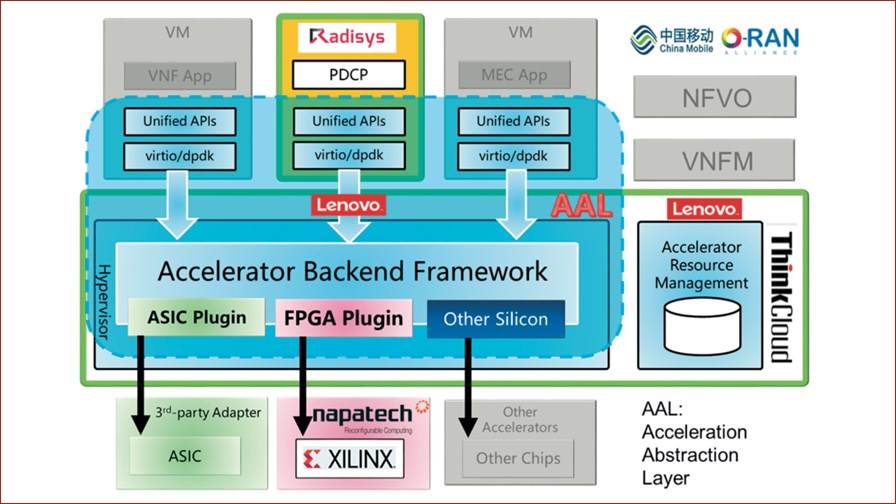
© Napatech
- Developed by China Mobile, Lenovo, Xilinx, Napatech and Radisys
- Solution supports heterogeneous NFVi acceleration hardware
- Speeds up encryption and decryption algorithms by a factor of ten
- Achieves 20 times lower latency than software solutions
Last week we reported on the inaugural Board Meeting of the O-RAN Alliance of telecoms operators seeking to develop open RAN solutions. One of the questions we posed was whether or not there would be a sufficiently large ecosystem of developers and vendors willing to work towards the O-RAN Alliance’s new specifications. It took just a few days before the first real evidence of vendor (or perhaps more accurately alt-vendor) support to emerge.
Under the guidance of China Mobile, vendors Lenovo, Xilinx, Napatech and Radisys used the Mobile World Congress Shanghai event to jointly demonstrate the industry’s first cloud-RAN solution that supports heterogeneous acceleration hardware and full decoupling of software and hardware. The diagram above illustrates their combined architecture approach.
“This joint project will help mature the total technical solutions for cloudification of the mobile wireless networks,” said Dr. Chih-Lin I, Chief Scientist of the China Mobile Research Institute. “This is a valuable step towards NFV general-purpose hardware accelerator solutions. We hope to use programmable hardware accelerators to improve the overall energy efficiency of the NFV platform and reduce the total cost, provided that all software and hardware can be fully decoupled, even for RAN.”
According to China Mobile, current NFVi hardware acceleration solutions (which are necessary for improved NFV performance) are problematic, with customized-function designs and non-unified interfaces, meaning it is difficult to decouple software from hardware. China Mobile therefore pushed its partners to develop hardware accelerators enabled with programmable hardware and unified APIs with open source community contributions.
Building the solution
The joint demo used the Lenovo ThinkCloud Accelerator solution, including Lenovo ThinkCloud NFVi carrier-grade cloud platform software, x86 servers and switches. Lenovo says its NFVi platform can automatically adapt and support acceleration hardware from different vendors and of different types. By abstracting and virtualizing the acceleration hardware, it provides a unified API to VNF applications, reducing the complexity of application development and porting, as well as enabling full decoupling of application software and acceleration hardware.
“RAN cloudification and virtualization are important technology directions in the 5G era and will have far-reaching significance on optimizing operators’ network efficiency, enabling business innovation, and enhancing user experience,” said Dr. Ying Huang, VP of Lenovo and Head of Enterprise & Cloud Research and 5G Research Labs at Lenovo Research.
The acceleration hardware in the joint solution includes Napatech’s SmartNICs based on Xilinx all-programmable FPGA products and third-party adapters based on ASIC designs. This reportedly delivers increased throughput and lower latency for network data forwarding and compute-intensive applications, such as Open vSwitch (OVS) and cryptography algorithms in the mobile base station’s packet data convergence protocol (PDCP) processing, as well as significantly reducing CPU utilisation and lowering costs.
“The current NFV deployment model for virtualized RANs uses x86 servers, but it is experiencing major performance bottlenecks in practice,” explained Jarrod Siket, CMO of Napatech. “By offloading the complex network and security tasks to FPGA-based SmartNICs, operators can maintain the NFV model of using commodity server infrastructure for VNF processing without compromising the performance, latency cost and power goals that LTE and 5G applications require.”
Radisys provided the VNF for the PDCP protocol stack, which supports running in a single Virtual Machine, as well as flexible extension to multiple VMs, providing elastic scaling that can meet the different processing requirements under varying load conditions.
“Radisys is delighted to continue our strong collaboration with the various partners for this important demonstration of 5G vRAN evolution for real-world deployment scenarios,” said Neeraj Patel, vice president and general manager Software & Services Solutions, Radisys.
“The Accelerator Abstract Layer (AAL)API based C-RAN accelerator platform deployed with Radisys’ PDCP Stack on Lenovo server and cloud software platforms demonstrates the advantages such as flexibility, guaranteed latency and performance gains of FPGA based acceleration in Telco cloud,” said Farhad Shafai, VP Communications Markets at Xilinx.
Performance gains
The vendor partners say they demonstrated the full decoupling of the PDCP VNF software and the NFVi software and hardware platform. They claim that the same PDCP software, without modifications, can automatically run on top of FPGA- or ASIC-based acceleration hardware and speed up the ZUC encryption and decryption algorithms by a factor of ten – and when no acceleration hardware is present, the VNF will automatically choose the CPU-based, software-only implementation. Compared to the software-only implementation, it also reportedly achieves 20 times lower latency.
The partners will now optimize the solution and improve performance. They also encourage more companies to join the collaboration. “We look forward to more partners joining O-RAN Alliance and continue this pursuit of a truly green, soft, open and smart future network,” added Chih-Lin I of the CMRI.
Email Newsletters
Sign up to receive TelecomTV's top news and videos, plus exclusive subscriber-only content direct to your inbox.




